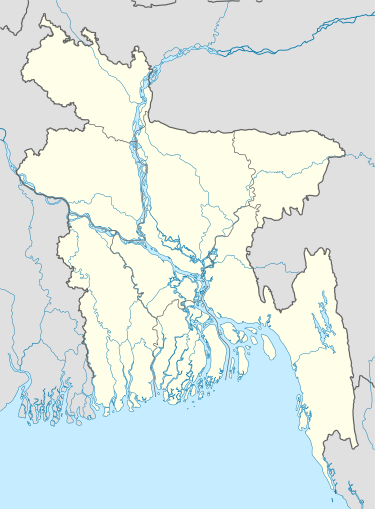Palashpur
| Matiranga মাটিরাঙ্গা | |
|---|---|
| Upazila | |
 Matiranga Location in Bangladesh | |
| Coordinates: 23°2.5′N 91°52.5′E / 23.0417°N 91.8750°E | |
| Country |
|
| Division | Chittagong Division |
| District | Khagrachari District |
| Area | |
| • Total | 495.39 km2 (191.27 sq mi) |
| Population (1991) | |
| • Total | 71,949 |
| • Density | 145/km2 (380/sq mi) |
| Time zone | BST (UTC+6) |
| Website |
bangladesh |
Haider Ali Talukder, founder of Palashpur village[1]
Palashpur is a village in Matiranga (Bengali: মাটিরাঙ্গা) Upazila of Khagrachari (Bengali: খাগড়াছড়ি) District, Bangladesh. Palashpur village was named and made habitable by Mr. Haider Ali Talukder [2] and few of his comrades. The village covers an area of 7.43 km2 (approx) and is surrounded by Hatiapara village to the East, Kheda Chhara to the North, Ojodda to the West and Matiranga Sadar to the South. Palashpur under Matiranga Pourashava was established in 1981. The village consists of three wards and few Mahallas. The village has a primary school (Palashpur Primary School), four mosques, a madrasa, three community schools and about five small hills. Non-governmental organizations operating in Palashpur include UNDP, BDAO (Bangladesh Development Acceleration Organisation), Grameen Bank, BRAC, ASA.
History
Palashpur was one of the most fearful and deep jungle areas in the district. Nobody had the courage to enter the area due to the prevalence of tribal terrorism activities (in Bengali these terrorists are called Shantibahinee). Nobody couldn’t think of going there let alone living there. Mr. Haider Ali Talukder was first man who visited this area and created a modern village and named it Palashpur.[3]
Mr. Haider Ali Talukdar was born December 28, 1957 in Gopalgonj District, Bangladesh.[4] He was a famous business man in Dhaka during late seventies. When he went Khagrachhary he was the Chairman of “tribal and non-tribal rehabilitation project”. Then he worked there for homeless people of Bangladesh. He rehabilitated a lot of tribal and non-tribal people in hilly district from different corners of the country.[5]
Palashpur was a deep jungle area. He cut about 3 square kilometre area of jungle for establishing a small village. He wanted to rehabilitate some people here. Finally he was able to clear this area with the help of local people. He named this newly formed village as “Palashpur” according to name of his 2nd son Mohammad Kamruzzaman Palash.[6] He rehabilitated more than 300 people in Palashpur from various districts of Bangladesh. He established a school namely “Palashpur Primary School”, a mosque “Palashpur Jame Masjid” and “Palashpur Madrasha”.[7] He also constructed a road from Palashpur to Hatiapara and named it “Mitaly Road”. Another road from Palashpur to Alutila Bazar was also constructed by him which local people now call it “Haider Road”. Recently Palashpur has declared as municipal area under Matiranga Pourashava though many modern civic facilities are still to be reached to the many people of the area. A highway from Matiranga to Taindong is passing through Palashpur. Palashpur BDR zone (Bangladesh Rifles Zone) is located at Kheda Chhara.[8] Mr. Haider Ali Talukder also a freedom fighter at liberation war of Bangladesh in 1971, worked at news paper named "Protirodh" which mainly inspired to the freedom fighter during liberation war of Bangladesh 1971. The Protirodh secretly published from Dhaka and Khulna by using Duplicator Machine.
Geography
Palashpur is located under Matiranga Upazila (Geographic coordinates of Matiranga Upazila is 23°02′30″N 91°52′30″E / 23.0417°N 91.8750°E and time zone GMT+6). Matiranga Upazila has 14948 units of households and total area of 495.39 km².[9]
Heritage
There are few numbers of beautiful small hills in Palashpur. A small canal flows behind Palashpur Primary School. There is also a small lake in the area. Alutila, the most beautiful area in the district is only 10 kilometer (approx) far from Palashpur. There is a very beautiful fountain “Richik fountain” in Alutila. This fountain flows through a granite’s hole which is around 500 years old.[10]
Demography
Palashpur has a population of 1500 of which 66.65% are male and 33.35% are female, 44.70% are tribal and 55.30% are non-tribal. Average population density is 201 per km2. The literacy rate among the villagers is 15.75%. The main occupations of residents of Palashpur are: Agriculture (51.22%), various labourers (30.45%), commerce (10.54%), service (2%), fishing (1.20%), and other (4.59%).[11]
Religious composition (1991)

Muslim - 47.45%, Buddhist - 35.51%, Hindu - 16.69%, Christian - 0.27% and Others - 0.08%.[12]
Economy
The main agricultural productions in Palashpur are paddy, sugarcane, onion, garlic, pineapple, betel leaf, vegetables and sweet potato. People in Palashpur also produce fruits like banana, jack fruit, mango, papaya, palm, guava, lemon, litchi, coconut, and guava and so on. There are fisheries, hatcheries, poultry and dairy farms in Palashpur. Palashpur is also a great resource of different types of Woods. In Palashpur there is a large Wood Mill where various types of boxes, cartoons and hardboards are produced.[13]
Natural animals
A lot of domestic and wild animals are found in Palashpur. Among the wild animals monkey, few elephants, wild cock, fox, large and poisonous snakes etc. are mentionable.
References
- ↑ Haider Ali Talukder, founder of Palashpur
- ↑ American Chronicle
- ↑ California Chronicle
- ↑ Boston University, Anna Howard Shaw Center, School of Theology
- ↑ World Sentinel
- ↑ Mohammad Kamruzzaman Palash
- ↑ Haidar Ali Talukdar
- ↑ World News Chronicle
- ↑ American Chronicle
- ↑ Matiranga Map — Satellite Images of Matiranga. MapLandia
- ↑ "Population Census Wing, BBS.". Archived from the original on 2005-03-27. Retrieved November 10, 2006.
- ↑ Amar Desh
- ↑ Modern Ghana News
- Documents from Matiranga Powroshava
- Discuss with village peoples
- Reference from Palashpur village’s founder Mr. Haider Ali Talukder
- Amar Desh
External links
Coordinates: 23°14′N 89°57′E / 23.233°N 89.950°E